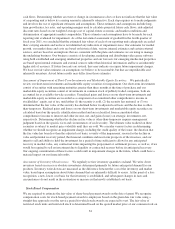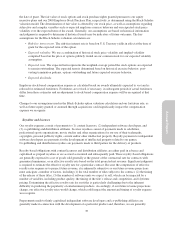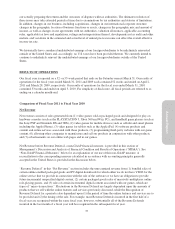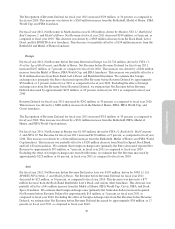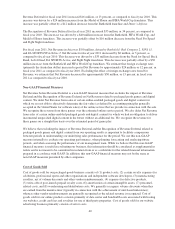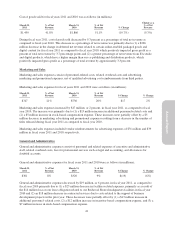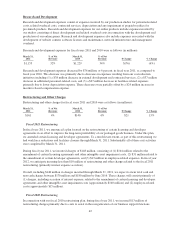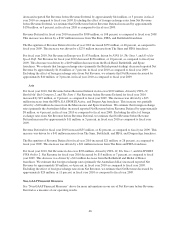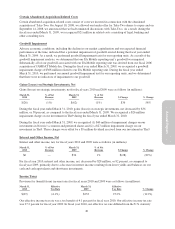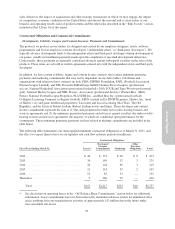Electronic Arts 2011 Annual Report Download - page 120
Download and view the complete annual report
Please find page 120 of the 2011 Electronic Arts annual report below. You can navigate through the pages in the report by either clicking on the pages listed below, or by using the keyword search tool below to find specific information within the annual report.
tax benefit, and non-deductible stock-based compensation expenses, partially offset by benefits related to the
resolution of examinations by the taxing authorities and reductions in the valuation allowance of U.S. deferred
tax assets.
Our effective income tax rates for fiscal year 2012 and future periods will depend on a variety of factors,
including changes in the deferred tax valuation allowance, as well as changes in our business such as acquisitions
and intercompany transactions, changes in our international structure, changes in the geographic location of
business functions or assets, changes in the geographic mix of income, changes in or termination of our
agreements with tax authorities, applicable accounting rules, applicable tax laws and regulations, rulings and
interpretations thereof, developments in tax audit and other matters, and variations in our annual pre-tax income
or loss. We incur certain tax expenses that do not decline proportionately with declines in our pre-tax
consolidated income or loss. As a result, in absolute dollar terms, our tax expense will have a greater influence on
our effective tax rate at lower levels of pre-tax income or loss than at higher levels. In addition, at lower levels of
pre-tax income or loss, our effective tax rate will be more volatile.
Certain taxable temporary differences that are not expected to reverse during the carry forward periods permitted
by tax law have not been considered as a source of future taxable income that is available to realize the benefit of
deferred tax assets.
The Tax Relief, Unemployment Insurance Reauthorization, and Job Creation Act of 2010 (the “Act”) was signed
into law on December 17, 2010. The Act contains a number of provisions including, most notably, a two year
extension of the research tax credit. The Act will not have a material impact on our effective tax rate for fiscal
2012 due to the effect of the valuation allowance on our deferred tax assets.
The Worker, Homeownership and Business Assistance Act of 2009 (“the Act”) was signed into law on
November 6, 2009. The Act provides that taxpayers may elect to increase the carry back period for tax losses
incurred in a taxable year beginning or ending in either 2008 or 2009. During the fiscal quarter ended
December 31, 2009, we elected to increase the carry back period for tax losses incurred in fiscal year 2009. This
election resulted in a reduction in the valuation allowance on our U.S. deferred tax assets due to an increase in
the sources of taxable income from the extended carry back period. As a result, we recorded a tax benefit of
approximately $28 million in the fiscal quarter ended December 31, 2009 for the reduction in the valuation
allowance.
We historically have considered undistributed earnings of our foreign subsidiaries to be indefinitely reinvested
outside of the United States and, accordingly, no U.S. taxes have been provided thereon. We currently intend to
continue to indefinitely reinvest the undistributed earnings of our foreign subsidiaries outside of the United
States.
Comparison of Fiscal Year 2010 to Fiscal Year 2009
Net Revenue
From a geographical perspective, our total Net Revenue for the fiscal years ended March 31, 2010 and 2009 was
as follows (in millions):
Year Ended March 31,
2010 2009
North
America Europe Asia Total
North
America Europe Asia Total
Net Revenue before Revenue Deferral . . . $ 2,322 $1,615 $ 222 $ 4,159 $2,362 $1,521 $203 $ 4,086
Revenue Deferral .................... (1,255) (981) (122) (2,358) (538) (472) (67) (1,077)
Recognition of Revenue Deferral ....... 958 799 96 1,853 588 540 75 1,203
Net Revenue ..................... $2,025 $1,433 $ 196 $ 3,654 $2,412 $1,589 $211 $ 4,212
44


